 |
| June 11, 2019 | Volume 15 Issue 22 |
Designfax weekly eMagazine
Archives
Partners
Manufacturing Center
Product Spotlight
Modern Applications News
Metalworking Ideas For
Today's Job Shops
Tooling and Production
Strategies for large
metalworking plants
Most powerful Ferrari ever is company's first hybrid-electric vehicle
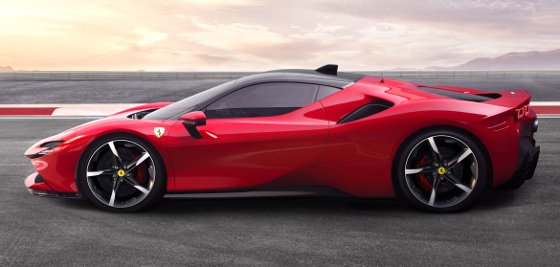
Ferrari's latest creation is its most extreme ever. The 986-hp SF90 Stradale is the Prancing Horse's first series production plug-in hybrid-electric vehicle (PHEV), and the company says it needs all-wheel drive "to allow the incredible power unleashed by the hybrid powertrain to be fully exploited."
That means 0 to 100 km/h (0 to 62 mph) in 2.5 sec and 0 to 200 km/h (124 mph) in just 6.7 sec.
Wow. Hope it comes with designer neck restraints! Max speed is listed as 340 km/h (211 mph).

The SF90 Stradale, designated "90" in a nod to the brand's 90th anniversary of the foundation of Scuderia Ferrari, sports other impressive numbers, including a weight-to-power ratio of 1.57 kg/cv and 390 kg of downforce at 250 km/h. The engine also delivers 800 Nm of torque at 6,000 rpm.
The supercar has a mid-mounted 90-degree V-8 turbo engine capable of delivering 780 cv (769 hp), the highest power output of any 8-cylinder in Ferrari history. Ferrari says the remaining 220 cv (217 hp) is delivered by three electric motors, one at the rear, known as the MGUK (Motor Generator Unit - Kinetic) due to its derivation from a Formula 1 application, located between the engine and the new 8-speed dual-clutch transmission on the rear axle, and two on the front axle.
The driver won't notice the dual system, though. Just select one of the four power unit modes and concentrate on driving. The sophisticated control logic takes care of the rest, managing the flow of power between the V-8, the electric motors, and the batteries.
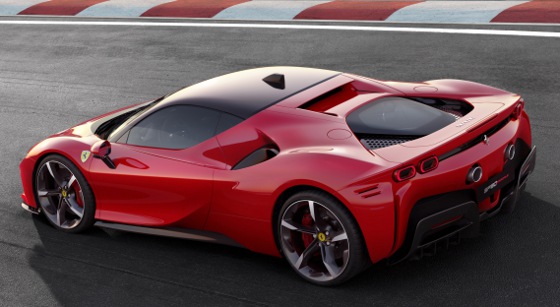
Ferrari says its engineers were able to broaden the spectrum of dynamic controls by introducing the full-electric front axle, known as the RAC-e (electronic cornering set-up regulator). As well as exclusively providing propulsion in electric drive, the two front motors independently control the torque delivered to the two wheels, extending the concept of Torque Vectoring. Fully integrated into the car's vehicle dynamics controls, the RAC-e governs the distribution of torque, making driving on the limit much simpler and easier.
But two systems usually means more components and more weight -- a challenge resolved by an obsessive attention to detail by the car's designers and builders and the overall optimization of the whole of the vehicle. For maximum performance in terms of overall weight, rigidity, and center of gravity, the chassis and body shell is all new, built using multi-material technology, including carbon fiber.
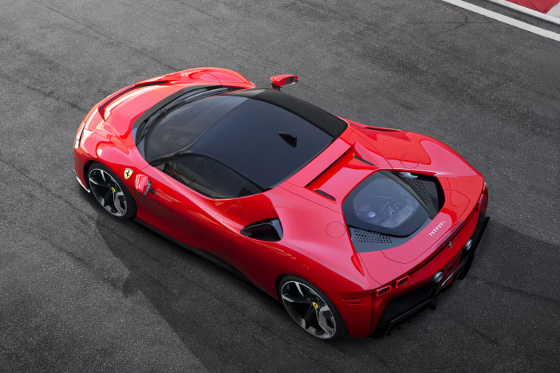
Other design changes from the standard Ferrari stable include that the intake and exhaust system was completely redesigned and now features a new, narrower cylinder head with a central injector, and the adoption of a 350-bar gasoline direct injection (GDI) pump -- another first for a Ferrari V-8.
To improve the internal fluid dynamics, not only was a larger-diameter intake valve adopted, but the ducts are all horizontally lined up at engine-head height; the turbo charger assembly has been lowered while the exhaust line is higher, evidenced by the fact that the tail pipes are now in the upper section of the rear bumper. The turbos are equipped with electronically controlled wastegates to improve catalyzer heating and new compressor volutes to optimize fluid dynamics.
The SF90 Stradale sports a completely redesigned 8-speed, oil-bath, dual-clutch transmission. New gear ratios and improved transmission efficiency yield a significant reduction in fuel consumption in urban and motorway driving without having to compromise on performance. Surprisingly, there is even a 1 percent improvement in efficiency on the track.
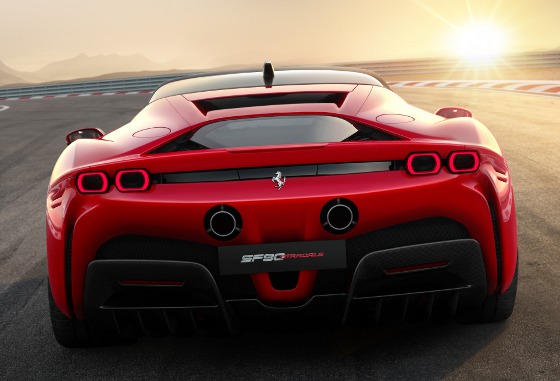
Despite the addition of an eighth gear and a maximum torque boost to 900 Nm (the latter an increase of 20 percent on the current Ferrari 7-speed), the gearbox's overall weight is actually 7 kg lower. That number rises when you figure in the elimination of the reverse gear, which is now incorporated into the function of the front electric wheel motors.
Ferrari also says the new clutch's performance is 35 percent higher, transmitting up to 1,200 Nm in dynamic torque in gear shifts. Thanks to new-generation actuation hydraulics, total clutch fill times have been cut to 200 ms compared to the Ferrari 488 Pista's 300 ms.
As for its hybrid performance, the SF90 Stradale is equipped with three electric motors capable of generating a total of 220 cv (162 kW). A high-performance Li-ion battery provides power to all three motors and guarantees a 25-km range in all-electric eDrive mode, using just the front axle.
The chassis has been completely redesigned with a multi-material and multi-technology approach to absorb the extra stresses associated with the new power unit and the introduction of AWD. A number of technological innovations have been introduced, including hollow castings, which replace the traditional ribbed castings. Other new solutions include an all-carbon-fiber bulkhead between the cabin and the engine and two new aluminum alloys, one of which is a high-strength 7000 series alloy for some of the sheet metal. As a result, the SF90 Stradale chassis boasts 20 percent higher bending stiffness and 40 percent higher torsional rigidity than previous platforms without any increase in weight.
In another neat touch, the engine cover has been kept extremely low to improve the interaction between the flows over and under the body, minimizing drag. The end section of the engine cover features a suspended wing divided in two sections: one fixed, which incorporates the third brake light, and one mobile with a wedge-shaped front area. The latter has been dubbed the "shut-off Gurney" and is under patent. It is also the most innovative downforce management device on the car.
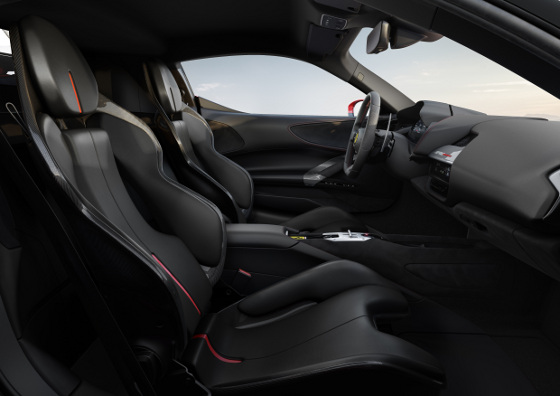
In urban usage or at maximum speed, the two sections are aligned and suspended above the engine cover, with the mobile wedge acting as an efficient fairing to the fixed element, allowing the air to flow both above and beneath the shut-off Gurney. In high-downforce conditions (such as driving through corners, braking, or in abrupt changes of direction), the mobile element is lowered by a pair of electric actuators, closing the lower blown area and uncovering the fixed element, and generating a new tail geometry. The system is controlled by a sophisticated control logic that checks parameters such as speed, acceleration (lateral and longitudinal), and driver inputs hundreds of times a second in order to establish the most efficient configuration to adopt.
The compact, bubble-shaped cabin is shifted far forward, which is further emphasized by the geometry of the two body-colored rear flying buttresses that enclose the rear. Another signature update is the headlights, which move away from the L-shaped look to a slender, slit design integrated with the brake air intakes and resulting in a characteristic C-shape that gives the front of the car an original and futuristic look. In an another first for a Ferrari, the SF90 Stradale uses matrix LED headlight technology to improve visibility in all driving conditions, thanks to active beam control.
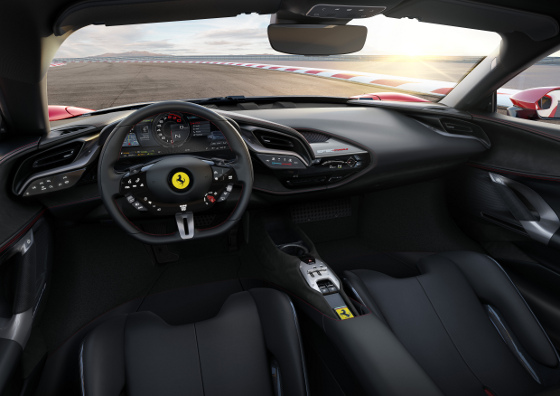
Because the powertrain is significantly lower in the car than in the past, the designers were also able to lower the car's tail. Another deviation from the styling typical of past berlinettas is the way the profile of the rear screen no longer follows the line from the roof to the rear bumper. This element of styling discontinuity is evidenced by the separation of the screen from the cooling grille.
Inside, the designers took a futuristic approach to the interface concept with a strong focus on creating a wraparound aeronautic-inspired cockpit with a particular emphasis on instruments.
In a first for a Ferrari, the central instrument cluster comprises a single 16-in. digital HD screen that curves toward the driver to make it easier to read. This design also emphasizes the F1-style wrap-around cockpit effect. This is the first time this type of screen has been adopted in a Ferrari production car. On-screen transitions have a 3D effect, which is in line with overall industry trends.
A Head Up Display is also included, and the steering wheel has a touchpad and a series of haptic buttons that allow the driver to control virtually every aspect of the car using just their thumbs.
Lastly, for the first time on a Ferrari, clients can choose between the standard car and a version with a more sports-oriented specification.
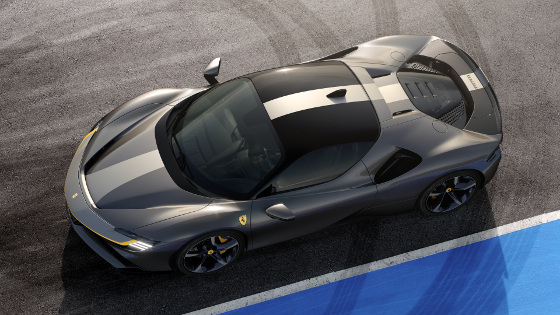
The Assetto Fiorano specification includes significant upgrades, including special GT racing-derived Multimatic shock absorbers, extra lightweight features made from high-performance materials such as carbon-fiber (door panels, underbody) and titanium (springs, entire exhaust line). The result is a weight savings of 30 kg. Another difference is the high-downforce carbon-fiber rear spoiler that generates 390 kg of downforce at 250 km/h. The Assetto Fiorano includes Michelin Pilot Sport Cup2 tires designed specifically to improve performance on the track. They feature a softer compound and fewer grooves than the tires provided as standard.
Learn more on the dedicated Ferrari SF90 Stradale page at www.ferrari.com/en-US/auto/sf90-stradale.
No price for the SF90 Stradale has been released, although it is rumored to cost just north of $500,000. Keep buying those Powerball tickets!
Source: Ferrari
Published June 2019
Rate this article
View our terms of use and privacy policy
